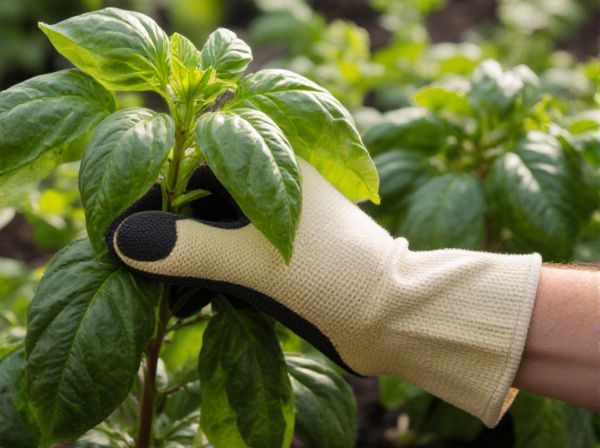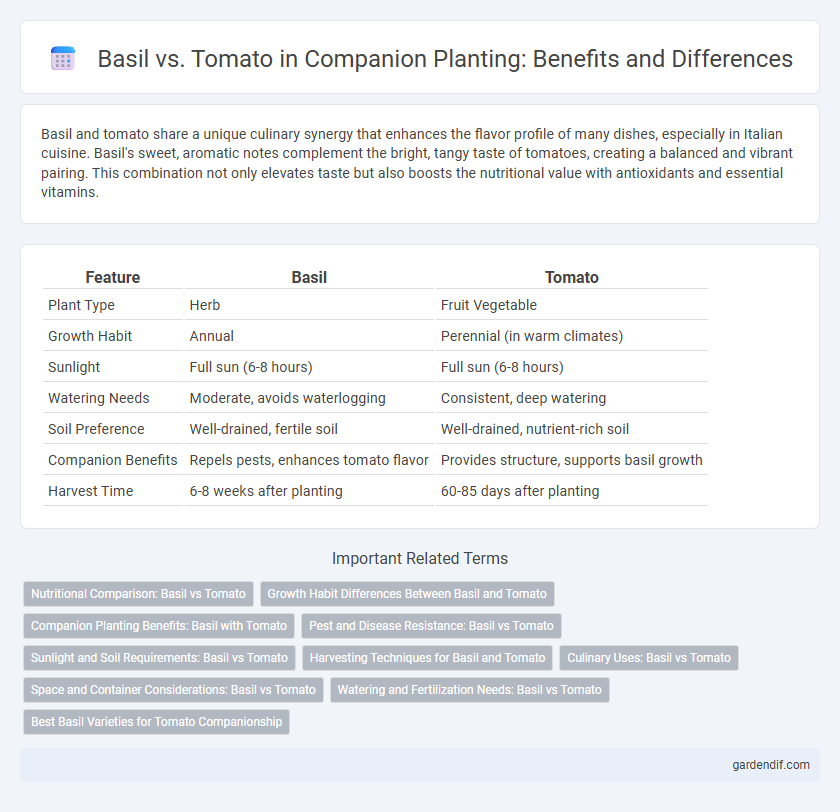
Basil vs tomato Illustration
Basil and tomato share a unique culinary synergy that enhances the flavor profile of many dishes, especially in Italian cuisine. Basil's sweet, aromatic notes complement the bright, tangy taste of tomatoes, creating a balanced and vibrant pairing. This combination not only elevates taste but also boosts the nutritional value with antioxidants and essential vitamins.
Table of Comparison
| Feature | Basil | Tomato |
|---|---|---|
| Plant Type | Herb | Fruit Vegetable |
| Growth Habit | Annual | Perennial (in warm climates) |
| Sunlight | Full sun (6-8 hours) | Full sun (6-8 hours) |
| Watering Needs | Moderate, avoids waterlogging | Consistent, deep watering |
| Soil Preference | Well-drained, fertile soil | Well-drained, nutrient-rich soil |
| Companion Benefits | Repels pests, enhances tomato flavor | Provides structure, supports basil growth |
| Harvest Time | 6-8 weeks after planting | 60-85 days after planting |
Nutritional Comparison: Basil vs Tomato
Basil contains high levels of vitamin K, essential for blood clotting, along with antioxidants such as flavonoids and polyphenols that support anti-inflammatory properties. Tomatoes provide a rich source of vitamin C, potassium, and lycopene, a powerful antioxidant linked to heart health and cancer prevention. Comparing the two, tomatoes offer greater vitamin C and potassium content, while basil excels in vitamin K concentration and specific bioactive compounds.
Growth Habit Differences Between Basil and Tomato
Basil exhibits a bushy, compact growth habit with multiple stems and dense foliage, making it ideal for container gardening and close planting. Tomato plants grow more vertically with a vining or sprawling habit, often requiring staking or support structures to manage their extensive growth. Understanding these growth habit differences helps optimize spacing, pruning, and care for healthy basil and tomato cultivation.
Companion Planting Benefits: Basil with Tomato
Basil enhances tomato growth by repelling harmful insects such as aphids, whiteflies, and tomato hornworms, reducing the need for chemical pesticides. It improves tomato flavor and boosts yields through the release of natural oils that attract pollinators and beneficial insects. Planting basil alongside tomatoes also promotes healthier soil by deterring fungal diseases like powdery mildew and fusarium wilt.
Pest and Disease Resistance: Basil vs Tomato
Basil exhibits strong resistance to common pests such as aphids, spider mites, and whiteflies, reducing the need for chemical interventions. Tomato plants often struggle with diseases like blight, fusarium wilt, and nematodes, requiring vigilant monitoring and treatment. Growing basil alongside tomatoes can enhance pest deterrence naturally while supporting overall plant health.
Sunlight and Soil Requirements: Basil vs Tomato
Basil thrives in full sunlight, ideally receiving 6 to 8 hours of direct sun daily, similar to tomatoes which also require full sun for optimal fruit production. Both plants prefer well-drained, nutrient-rich soil with a slightly acidic to neutral pH, between 6.0 and 7.0. However, basil is more sensitive to cold soil temperatures, demanding warmer conditions for proper growth compared to tomatoes.
Harvesting Techniques for Basil and Tomato
Harvesting basil requires pinching leaves frequently to encourage bushier growth and prevent flowering, ideally done in the morning to retain essential oils. Tomato harvesting focuses on picking fruit at peak ripeness, indicated by full color and slight softness, usually starting 60 to 85 days after transplanting. Proper harvesting methods improve yield quality and extend the productive life of both basil and tomato plants.
Culinary Uses: Basil vs Tomato
Basil enhances the flavor profile of dishes with its aromatic, sweet, and slightly peppery taste, making it a staple in Italian and Mediterranean cuisines, particularly in pesto, salads, and sauces. Tomato provides a juicy, tangy, and slightly sweet base that serves as a versatile ingredient in sauces, soups, and stews, enriching dishes with its natural umami. Combining basil and tomato intensifies the flavors in pasta, pizzas, and salads, creating a balanced and vibrant culinary experience.
Space and Container Considerations: Basil vs Tomato
Basil and tomato plants require distinct space and container conditions for optimal growth. Basil thrives in smaller containers with well-draining soil, needing about 6-12 inches of plant spacing, while tomatoes demand larger pots of at least 5 gallons and 18-24 inches between plants to accommodate their extensive root systems. Proper container size and adequate spacing prevent root overcrowding and support healthy development, maximizing yield for both herbs.
Watering and Fertilization Needs: Basil vs Tomato
Basil requires consistent watering to keep the soil moist but not waterlogged, whereas tomatoes need deeper, less frequent watering to promote strong root development. Fertilization for basil involves balanced nitrogen-rich nutrients every 4-6 weeks, while tomatoes benefit from higher phosphorus and potassium levels to support fruit production. Properly managing watering and fertilization enhances the growth and yield of both basil and tomato plants when grown together.
Best Basil Varieties for Tomato Companionship
Sweet Genovese basil stands out as the best companion for tomatoes due to its strong aroma that repels pests such as aphids and whiteflies. Purple basil varieties like 'Dark Opal' not only enhance the visual appeal of tomato gardens but also deter harmful insects while improving tomato flavor. Lemon basil is another excellent choice, offering a citrusy aroma that attracts beneficial pollinators and supports healthy tomato growth.
Basil vs tomato Infographic

 gardendif.com
gardendif.com